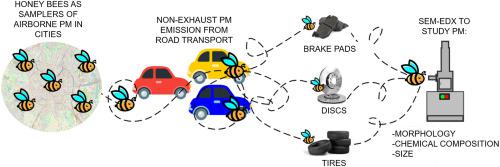Environmental Pollution ( IF 8.9 ) Pub Date : 2023-05-24 , DOI: 10.1016/j.envpol.2023.121885 Marco Pellecchia 1 , Giulia Papa 2 , Mario Barbato 3 , Giancarlo Capitani 4 , Ilaria Negri 5

|
Urban areas present multiple challenges to scientists interested in unraveling the source, transport, and fate of airborne particulate matter (PM). Airborne PM consists of a heterogeneous mixture of particles with different sizes, morphologies, and chemical compositions. However, standard air quality stations only detect the mass concentration of PM mixtures with aerodynamic diameters ≤10 μm (PM10) and/or ≤ 2.5 μm (PM2.5). During honey bee foraging flights, airborne PM up to 10 μm in size attaches to their bodies, making them suitable for collecting spatiotemporal data on airborne PM. The individual particulate chemistry of this PM can be assessed using scanning electron microscopy coupled with energy-dispersive X-ray spectroscopy on a sub-micrometer scale, allowing accurate identification and classification of the particles.
Herein, we analyzed the PM fractions of 10–2.5 μm, 2.5–1 μm, and below 1 μm in average geometric diameter collected by bees from hives located in the city of Milan, Italy. Bees showed contamination by natural dust, originating from soil erosion and rock outcropping in the foraging area, and particles with recurrent heavy metal content, most likely attributed to vehicular braking systems and possibly tires (non-exhaust PM). Notably, approximately 80% of non-exhaust PM was ≤1 μm in size. This study provides a possible alternative strategy to apportion the finer fraction of PM in urban areas and determine citizens’ exposure. Our findings may also prompt decision-makers to issue policy addressal for non-exhaust pollution, especially for the ongoing restructuring of European regulations on mobility and the shift toward electric vehicles whose contribution to PM pollution is debated.
中文翻译:

通过对蜜蜂 (Apis mellifera) 收集的颗粒进行个体分析,确定城市中非排放 PM 的来源
城市地区对有兴趣了解空气中颗粒物 (PM) 的来源、运输和归宿的科学家提出了多重挑战。空气中的 PM 由具有不同大小、形态和化学成分的颗粒组成。然而,标准空气质量站仅检测空气动力学直径≤10 μm (PM 10 ) 和/或 ≤ 2.5 μm (PM 2.5). 在蜜蜂觅食飞行期间,空气中最大 10 μm 的 PM 附着在它们的身体上,使它们适合收集空气中 PM 的时空数据。可以使用扫描电子显微镜结合亚微米级能量色散 X 射线光谱法评估这种 PM 的单个颗粒化学成分,从而准确识别和分类颗粒。
在此,我们分析了蜜蜂从位于意大利米兰市的蜂巢收集的平均几何直径为 10–2.5 μm、2.5–1 μm 和低于 1 μm 的 PM 分数。蜜蜂受到天然灰尘的污染,源自觅食区的土壤侵蚀和岩石露头,以及反复出现重金属含量的颗粒,最有可能归因于车辆制动系统和可能的轮胎(非排气 PM)。值得注意的是,大约 80% 的非废气 PM 的尺寸≤1 μm。本研究提供了一种可能的替代策略来分配城市地区 PM 的更精细部分并确定公民的暴露。我们的研究结果还可能促使决策者针对非尾气污染发布政策地址,


























 京公网安备 11010802027423号
京公网安备 11010802027423号